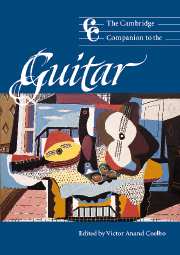Book contents
- Frontmatter
- Part I New guitar histories and world traditions
- 1 Picking through cultures: a guitarist's music history
- 2 Flamenco guitar: history, style, status
- 3 The Celtic guitar: crossing cultural boundaries in the twentieth century
- 4 African reinventions of the guitar
- Part II Jazz, roots, and rock
- Part III Baroque and classical guitar today
- Glossary
- Notes
- Select bibliography
- General index
- Index of song and album titles
1 - Picking through cultures: a guitarist's music history
from Part I - New guitar histories and world traditions
Published online by Cambridge University Press: 28 September 2011
- Frontmatter
- Part I New guitar histories and world traditions
- 1 Picking through cultures: a guitarist's music history
- 2 Flamenco guitar: history, style, status
- 3 The Celtic guitar: crossing cultural boundaries in the twentieth century
- 4 African reinventions of the guitar
- Part II Jazz, roots, and rock
- Part III Baroque and classical guitar today
- Glossary
- Notes
- Select bibliography
- General index
- Index of song and album titles
Summary
Prelude: finding the guitar in history
The history of the modern guitar begins in the culture of late medieval Europe, where we find the first unequivocal evidence of the characteristic figure-eight-shaped instrument in court documents, images, and poetry of the fifteenth century. By the Renaissance, the guitar had developed a sizable and idiomatic repertory written in tablature and it became standardized enough in construction, tuning, and technique to permit an explosive realization of its potential in seventeenth- and early eighteenth-century Italy, Spain, and France. By the nineteenth century, the guitar thrived in salon culture and on the concert stage, producing dazzling virtuosos and laying the foundations for what is now largely accepted as the guitar's core “classical” repertoire.
From this point on the instrument's development becomes much less indebted to its classical past. In fact, its role in Western art-music over some 600 years is but one small chapter of a much larger story concerning the enormous global impact the instrument has had since 1900. By contrast with the piano, whose developments in structure and repertoire were conditioned almost exclusively by the art-music tradition until the early twentieth century, the guitar's development is made up of multiple and overlapping histories. To put it another way, guitar history simultaneously spans popular and classical styles, urban and rural techniques, contemporary and historical practices, written and unwritten traditions, and Western and non-Western cultures, revealing the contributions of both formally and un-formally trained players.
- Type
- Chapter
- Information
- The Cambridge Companion to the Guitar , pp. 1 - 12Publisher: Cambridge University PressPrint publication year: 2003
- 1
- Cited by



